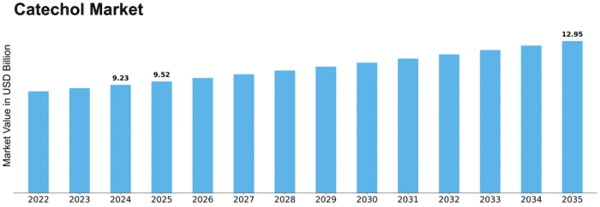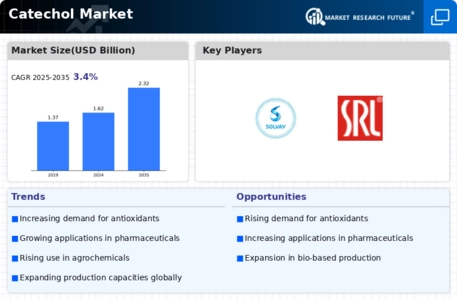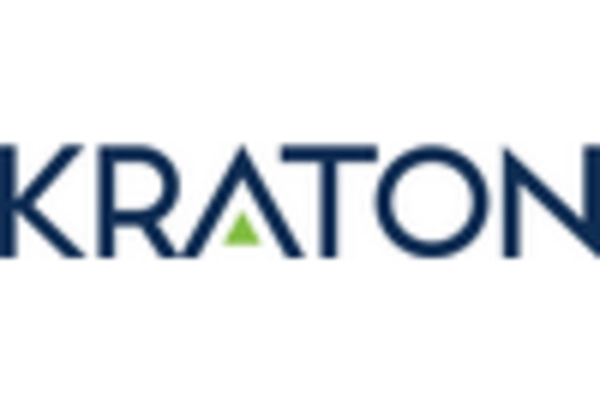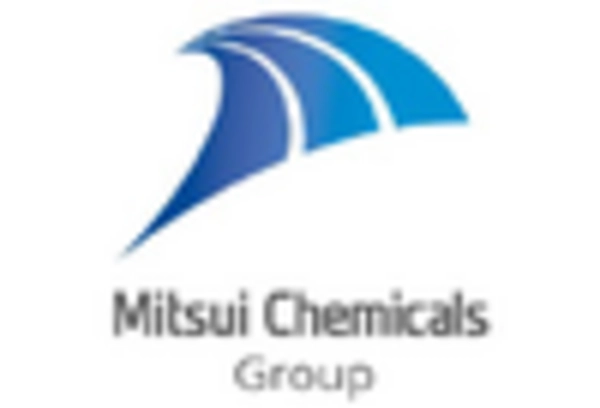-
Executive Summary
-
Market Introduction
-
Market Definition
-
Scope of the
- Research
- Assumptions & Limitations
-
Study
-
Objectives
-
Markets Structure
-
Key Takeaways
-
Market Research Methodology
-
Research Process
-
Primary Research
-
Secondary Research
-
Market Size Estimation
-
Forecast Model
-
Market Dynamics of the Global Catechol
-
Market
-
Introduction
-
Drivers
-
Restraints
-
Opportunities
-
Challenges
-
Trends/Technology
-
Market Factor Analysis of the
-
Global Catechol Market
-
Supply Chain
- Raw Material Suppliers
- Manufacturers/Producers
- Distributors/Retailers/Wholesalers/E-Commerce
-
Analysis
-
End User
-
Porter’s
- Threat of New
- Bargaining Power of Buyers
- Bargaining Power of Suppliers
- Threat of Substitutes
-
Five Forces Analysis
-
Entrants
-
Intensity of Competitive Rivalry
-
Pricing Analysis
-
Global Catechol Market, by Form
-
Introduction
-
Flakes
- Market
-
Market Estimates & Forecast, 2020−2027
-
Estimates & Forecast, by Region, 2020−2027
-
Molten
- Market Estimates
- Market Estimates & Forecast,
-
& Forecast, 2020−2027
-
by Region, 2020−2027
-
Global Catechol Market, by
-
End Use
-
Introduction
-
Pharmaceutical
- Market Estimates & Forecast, 2020−2027
-
Market Estimates & Forecast, by Region, 2020−2027
-
Agrochemical
-
Food & Beverage
-
Personal Care & Cosmetics
-
Market Estimates & Forecast, 2020−2027
-
Market Estimates & Forecast, by Region, 2020−2027
-
Market Estimates & Forecast, 2020−2027
-
Market Estimates & Forecast, by Region, 2020−2027
-
Market Estimates & Forecast,
-
Market Estimates & Forecast, by Region, 2020−2027
-
Others
- Market Estimates & Forecast,
- Market Estimates & Forecast, by Region, 2020−2027
-
Global Catechol Market, by Region
-
Introduction
-
North America
- Market Estimates &
- Market Estimates & Forecast,
- Market Estimates & Forecast,
- US
- Canada
-
Forecast, 2020−2027
-
by Form, 2020−2027
-
by End Use, 2020−2027
-
& Forecast, by Form, 2020−2027
-
Market Estimates & Forecast, 2020−2027
-
Market Estimates & Forecast, by End Use, 2020−2027
-
Europe
-
Forecast, by Form, 2020−2027
-
Forecast, by Form, 2020−2027
-
by Form, 2020−2027
-
Market Estimates & Forecast, 2020−2027
-
Market Estimates & Forecast, by Form, 2020−2027
-
Market Estimates & Forecast, by End Use, 2020−2027
-
Germany
-
Market Estimates & Forecast, 2020−2027
-
Market Estimates &
-
Market Estimates & Forecast, by End Use, 2020−2027
-
France
-
Market Estimates & Forecast, 2020−2027
-
Market Estimates &
-
Market Estimates & Forecast, by End Use, 2020−2027
-
Italy
-
Market Estimates & Forecast, 2020−2027
-
Market Estimates & Forecast,
-
Market Estimates & Forecast, by End Use, 2020−2027
-
Spain
-
Market Estimates & Forecast, 2020−2027
-
& Forecast, by End Use, 2020−2027
-
& Forecast, 2020−2027
-
Forecast, by End Use, 2020−2027
-
Forecast, 2020−2027
-
Forecast, by End Use, 2020−2027
-
Forecast, 2020−2027
-
Forecast, by End Use, 2020−2027
-
& Forecast, 2020−2027
-
& Forecast, by End Use, 2020−2027
-
Market Estimates & Forecast, 2020−2027
-
Forecast, by Form, 2020−2027
-
& Forecast, by Form, 2020−2027
-
Market Estimates & Forecast, by Form,2020−2027
-
Market Estimates
-
UK
-
Market Estimates
-
Market Estimates & Forecast, by Form,2020−2027
-
Market Estimates &
-
Russia
-
Market Estimates &
-
Market Estimates & Forecast, by Form,2020−2027
-
Market Estimates &
-
Poland
-
Market Estimates &
-
Market Estimates & Forecast, by Form, 2020−2027
-
Market Estimates &
-
Rest of Europe
-
Market Estimates
-
Market Estimates & Forecast, by Form, 2020−2027
-
Market Estimates
-
Asia-Pacific
- Market Estimates & Forecast, 2020−2027
- Market Estimates & Forecast, by Form, 2020−2027
- Market Estimates & Forecast, by End Use, 2020−2027
- China
- India
- Japan
-
Market Estimates & Forecast, by Form, 2020−2027
-
by End Use, 2020−2027
-
New Zealand
-
Market Estimates & Forecast, 2020−2027
-
by Form, 2020−2027
-
Market Estimates & Forecast,
-
Australia &
-
Market Estimates & Forecast,
-
Market Estimates & Forecast, by End Use, 2020−2027
-
& Forecast, by Form, 2020−2027
-
Middle East & Africa
-
Forecast, 2020−2027
-
by Form, 2020−2027
-
by End Use, 2020−2027
-
& Forecast, by Form, 2020−2027
-
by Form, 2020−2027
-
Rest of Asia-Pacific
-
Market Estimates & Forecast, 2020−2027
-
Market Estimates
-
Market Estimates & Forecast, by End Use,
-
Market Estimates &
-
Market Estimates & Forecast,
-
Market Estimates & Forecast,
-
GCC
-
Market Estimates & Forecast, 2020−2027
-
Market Estimates
-
Market Estimates & Forecast, by End Use, 2020−2027
-
Israel
-
Market Estimates & Forecast, 2020−2027
-
Market Estimates & Forecast,
-
Market Estimates & Forecast, by End Use, 2020−2027
-
Forecast, by Form, 2020−2027
-
Forecast, by Form, 2020−2027
-
& Forecast, by Form, 2020−2027
-
Forecast, 2020−2027
-
by Form, 2020−2027
-
by End Use, 2020−2027
-
Forecast, 2020−2027
-
Forecast, by End Use, 2020−2027
-
& Forecast, 2020−2027
-
Forecast, by End Use, 2020−2027
-
& Forecast, 2020−2027
-
Forecast, by End Use, 2020−2027
-
America
-
Market Estimates & Forecast, 2020−2027
-
& Forecast, by End Use, 2020−2027
-
North Africa
-
Market Estimates & Forecast, 2020−2027
-
Market Estimates &
-
Market Estimates & Forecast, by End Use, 2020−2027
-
Turkey
-
Market Estimates & Forecast, 2020−2027
-
Market Estimates &
-
Market Estimates & Forecast, by End Use, 2020−2027
-
Rest of Middle East & Africa
-
Market Estimates & Forecast, 2020−2027
-
Market Estimates
-
Market Estimates & Forecast, by End Use, 2020−2027
-
Latin America
- Market Estimates &
- Market Estimates & Forecast,
- Market Estimates & Forecast,
- Brazil
- Argentina
- Mexico
- Rest of Latin
-
Company Landscape
-
Introduction
-
Market Strategies
-
Key Development Analysis
-
(Expansion/Merger & Acquisitions/Joint Venture/New Product Development/Agreement/Investment)
-
Company Profiles
-
Solvay
-
Company Overview
-
Key Developments
-
Company Overview
-
Key Developments
-
Financial Updates
-
Product/Business Segment Overview
-
Strategies
-
SWOT Analysis
-
Industry Co.
-
Company Overview
-
Key Developments
-
Financial Updates
-
Product/Business Segment Overview
-
Strategies
-
SWOT Analysis
-
Pvt. Ltd.
-
Financial Updates
-
Product/Business Segment Overview
-
Strategies
-
SWOT Analysis
-
Company Overview
-
Key Developments
-
Financial Updates
-
Product/Business Segment Overview
-
Key Strategies
-
SWOT Analysis
-
Camlin Fine Sciences Ltd
- Financial Updates
- Product/Business Segment Overview
- Key Strategies
- SWOT Analysis
-
UBE INDUSTRIES, LTD
- Company Overview
- Key
- Key Developments
-
Lianyungang Sanjili Chemical
- Financial Updates
- Product/Business Segment Overview
- Key Strategies
- SWOT Analysis
-
K. K. Poonja & Sons
- Company Overview
- Key
- Key Developments
-
Sisco Research Laboratories
- Company Overview
- Key
- Key Developments
-
Alfa Aesar
- Financial Updates
- Product/Business Segment Overview
- Key Strategies
- SWOT Analysis
-
Conclusion
-
LIST OF TABLES
-
Global Catechol Market: by Region, 2020−2027
-
North America: Catechol Market, by Country, 2020−2027
-
Europe: Catechol Market, by Country, 2020−2027
-
Asia-Pacific: Catechol Market. by Country, 2020−2027
-
Middle East & Africa: Catechol Market, by Country,
-
Latin America: Catechol Market, by
-
Country, 2020−2027
-
Global Catechol Form Market,
-
by Regions, 2020−2027
-
North America: Catechol
-
Form Market, by Country, 2020−2027
-
Europe:
-
Catechol Form Market, by Country, 2020−2027
-
Table10 Asia-Pacific:
-
Catechol Form Market, by Country, 2020−2027
-
Table11 Middle
-
East & Africa: Catechol Form Market, by Country, 2020−2027
-
Table12
-
Latin America: Catechol Form Market, by Country, 2020−2027
-
Table13
-
Global Catechol End Use Market, by Regions, 2020−2027
-
Table14
-
North America: Catechol End Use Market, by Country, 2020−2027
-
Table15
-
Europe: Catechol End Use Market, by Country, 2020−2027
-
Table16
-
Asia-Pacific: Catechol End Use Market, by Country, 2020−2027
-
Table17
-
Middle East & Africa: Catechol End Use Market, by Country, 2020−2027
-
Table18 Latin America: Catechol by End Use Market, by Country,
-
Table19 Global Form Market, by Region, 2020−2027
-
Table20 Global End Use Market, by Region, 2020−2027
-
Table21 North America: Catechol Market, by Country, 2020−2027
-
Table22 North America: Catechol Market, by Form, 2020−2027
-
Table23 North America: Catechol Market, by End Use, 2020−2027
-
Table24 Europe: Catechol Market, by Country, 2020−2027
-
Table25 Europe: Catechol Market, by Form, 2020−2027
-
Table26 Europe: Catechol Market, by End Use, 2020−2027
-
Table27 Asia-Pacific: Catechol Market, by Country,
-
Table28 Asia-Pacific: Catechol Market,
-
by Form, 2020−2027
-
Table29 Asia-Pacific: Catechol Market,
-
by End Use, 2020−2027
-
Table30 Middle East &
-
Africa: Catechol Market, by Country, 2020−2027
-
Table31 Middle
-
East & Africa: Catechol Market, by Form, 2020−2027
-
Table32
-
Middle East & Africa: Catechol Market, by End Use, 2020−2027
-
Table33 Latin America: Catechol Market, by Country, 2020−2027
-
Table34 Latin America: Catechol Market, by Form, 2020−2027
-
Table35 Latin America: Catechol Market, by End Use, 2020−2027
-
LIST OF FIGURES
-
Global Catechol
-
Market Segmentation
-
Forecast Research Methodology
-
Five Forces Analysis of the Global Catechol Market
-
FIGURE
-
Value Chain of the Global Catechol Market
-
FIGURE 5
-
Global Catechol Market, 2020−2027, by Country, 2020
-
Share
-
of the Global Catechol Market, by Form, 2020−2027
-
Global
-
Catechol Market Size, by Form, 2020
-
Share of the Global
-
Catechol Market, by Form, 2020−2027
-
Global Catechol
-
Market Size, by End Use, 2020
-
FIGURE10 Share of the Global Catechol
-
Market, by End Use, 2020−2027


















Leave a Comment